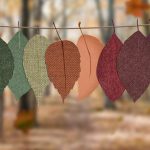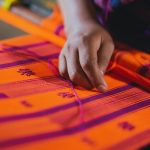If you're looking to elevate your fabric projects, exploring creative printing methods can be a game changer. You might find that techniques like screen printing and block printing offer a tactile approach, while digital fabric printing opens up a realm of intricate designs. Don't overlook eco-friendly options that not only enhance your work but also support sustainable practices. As you consider your next project, think about how stamping, stenciling, or even tie-dye could transform your fabric into something unique. Curious about which method might suit your style best?
Table of Contents
Key Takeaways
- Explore screen printing for sharp designs and color layering on various fabrics, perfect for intricate artwork.
- Try block printing for a hands-on approach, using carved blocks to create unique, custom patterns on natural fibers.
- Consider digital fabric printing for high-quality, vibrant prints with quick turnaround times and no minimum order requirements.
- Experiment with eco-friendly printing options, utilizing water-based inks and organic fabrics for sustainable and vibrant textile designs.
Screen Printing Techniques
Screen printing techniques allow you to create vibrant designs on various fabrics with precision and durability. This method involves pushing ink through a stencil or mesh screen, resulting in sharp, clean images that stand out. To get started, you'll need a few essential tools: a screen, a squeegee, and fabric ink.
First, prepare your design and transfer it onto the screen using a photo emulsion or a direct-to-screen method. Ensure the screen is tightly stretched and clean for the best results. Once your screen is ready, place it on the fabric, and use the squeegee to pull the ink across the mesh. This action forces the ink through the open areas of the stencil, printing your design onto the fabric below.
One of the greatest advantages of screen printing is its versatility. You can print on various materials, including cotton, polyester, and even canvas. Additionally, you can layer different colors to create complex designs.
Block Printing Basics
Block printing offers a hands-on approach to fabric design, allowing you to create unique patterns and textures with carved blocks. To get started, you'll need a few essential supplies: fabric, block printing ink, a carved block, and a brayer or roller. Choose your fabric wisely; natural fibers like cotton or linen work best for absorbing ink.
Begin by preparing your workspace. Lay down a protective covering and make sure you have a flat surface to work on. Apply a thin layer of ink to your block using the brayer, ensuring it's evenly coated. Then, press the block firmly onto your fabric, applying even pressure to transfer the design. Lift the block straight up to avoid smudging.
Experiment with different patterns, colors, and layouts to see what resonates with your style. Don't be afraid to mix and match; layering designs can create stunning effects. Once you've finished printing, let the fabric dry completely, and follow the ink manufacturer's instructions for heat-setting, if necessary.
With practice, you'll master block printing and produce beautiful, one-of-a-kind fabric designs that showcase your creativity.
Digital Fabric Printing
Digital fabric printing revolutionizes the way you can bring intricate designs and vibrant colors to life on fabric, offering endless possibilities for creativity and personalization. This method uses advanced technology to print digital images directly onto fabric, allowing you to experiment with patterns and colors that traditional methods can't achieve. You can easily create custom designs for apparel, home decor, or promotional items without the limitations of minimum orders.
One of the standout features of digital fabric printing is its ability to produce high-quality prints with remarkable detail. You can print photographs, complex graphics, and even gradients with ease. Plus, the turnaround time is often quicker than other methods, which means you can get your designs to market faster.
Here's a summary of some key benefits:
| Benefit | Description | Ideal Use |
|---|---|---|
| High Detail | Captures intricate designs | Fashion & Apparel |
| Quick Turnaround | Faster production times | Small Batches & Custom Orders |
| Versatile Materials | Works on various fabric types | Home Decor & Accessories |
| Eco-Friendly Options | Compatible with water-based inks | Sustainable Fashion |
Digital fabric printing opens up a world of possibilities for your creative projects.
Eco-Friendly Printing Options
When it comes to eco-friendly printing options, you'll want to consider using water-based inks that are less harmful to the environment.
Pairing these inks with organic fabric choices not only reduces your ecological footprint but also enhances the overall quality of your prints.
Let's explore how these options can make a positive impact on your fabric printing projects.
Water-Based Inks
Water-based inks offer a sustainable choice for fabric printing, reducing harmful emissions while delivering vibrant colors. Using these inks means you're not only making a creative choice but also an environmentally responsible one. They're made from natural materials, making them less toxic than traditional solvent-based inks. Plus, they're easier to clean up, which saves you time and effort.
Here's a quick comparison of water-based inks versus solvent-based inks:
| Feature | Water-Based Inks |
|---|---|
| Environmental Impact | Low |
| Toxicity | Non-toxic |
| Cleanup | Water-soluble |
Switching to water-based inks can enhance your printing projects while promoting a healthier planet. You'll find these inks can produce rich and vivid prints on various fabrics, from cotton to polyester blends. Their versatility means they're perfect for everything from clothing to home décor. When you choose water-based inks, you're not just printing; you're contributing to a more sustainable future. So, give them a try, and see how they can elevate your fabric printing experience!
Organic Fabric Choices
Exploring organic fabric choices opens up a world of eco-friendly printing options that not only enhance your designs but also support sustainable practices.
When you opt for organic fabrics like cotton, hemp, or linen, you're choosing materials that are grown without harmful pesticides and synthetic fertilizers. This not only benefits the environment but also creates healthier textiles for you and your customers.
Using organic fabrics with eco-friendly printing methods, such as water-based inks or natural dyes, ensures that your creations remain sustainable from start to finish. These inks are less toxic and can help you achieve vibrant colors without compromising your commitment to the planet.
Consider sourcing your fabrics from certified organic suppliers. Look for labels like GOTS (Global Organic Textile Standard) that guarantee sustainable practices throughout the production process.
Stamping and Stenciling
When it comes to stamping and stenciling on fabric, having the right tools can make all the difference.
You'll also want to explore various techniques to ensure your designs stand out beautifully.
Let's get into some creative design ideas that can inspire your next project!
Tools for Stamping Success
To achieve vibrant designs through stamping and stenciling, you'll need a few essential tools that make the process both efficient and enjoyable.
First, gather a variety of stamps and stencils. Look for stamps made from rubber or foam, as they provide clear impressions. For stencils, consider both plastic and cardboard options, depending on the durability you prefer.
Next, invest in high-quality fabric paints or inks. These mediums come in various colors and finishes, ensuring your designs pop. Don't forget to grab a brayer or sponge for even paint application on your stamps. A palette or plate will help you mix colors and keep your workspace organized.
You'll also need a flat surface to work on, ideally covered with a protective layer to avoid messes. Keep a set of brushes handy for touch-ups and detailing.
Techniques for Effective Stenciling
Mastering effective stenciling techniques can elevate your fabric designs, ensuring sharp lines and vibrant patterns.
To get started, choose a sturdy stencil material like mylar or acetate, which holds up well during the printing process. Make sure your stencil is securely placed on the fabric, using painter's tape or weights to prevent movement.
When applying paint, opt for a foam or stencil brush. Dip the brush lightly in paint, then offload excess on a paper towel to avoid bleeding under the stencil. Apply paint in a dabbing motion rather than brushing, which helps maintain precise edges. If you're using fabric paint, consider layering colors for depth but allow each layer to dry before adding the next.
For intricate designs, consider using a spray adhesive to temporarily bond the stencil to the fabric. This technique minimizes paint seepage and keeps your design crisp.
After printing, let your fabric cure according to the paint manufacturer's instructions to ensure longevity.
Creative Design Ideas
Exploring creative design ideas through stamping and stenciling can transform your fabric projects into unique masterpieces.
When you dive into these techniques, you'll discover endless possibilities to express your creativity. Here are some ideas to get you started:
- Nature-Inspired Prints: Use leaf or flower stamps to create organic patterns. Experiment with different colors for a vibrant, layered look.
- Geometric Designs: Create stencils with geometric shapes. Overlapping shapes can add depth and visual interest to your fabric.
- Textured Backgrounds: Use sponges or textured rollers for stamping. This method adds a dynamic background that enhances the overall design.
- Personalized Messages: Design custom stencils featuring quotes or phrases. This adds a personal touch to your fabric items, making them perfect for gifts or home decor.
Tie-Dye and Resist Methods
Tie-dye and resist methods offer vibrant ways to create unique patterns on fabric, making each piece a one-of-a-kind masterpiece. You can dive into this creative process with just a few materials: fabric, dye, and your choice of resist technique.
Start by folding, twisting, or crumpling your fabric to form interesting shapes. Secure it with rubber bands or string to create areas that won't absorb dye.
Next, choose your dye colors—bright hues make for striking designs. You'll want to work in a well-ventilated area and wear gloves to protect your hands.
Once you've applied the dye, let it sit for several hours or overnight, depending on how intense you want the colors. Rinse the fabric thoroughly in cold water until the water runs clear, then remove the resist materials. Finally, allow your creation to dry completely.
You'll find that each tie-dye or resist project has its own personality, thanks to the randomness of dye absorption. With practice, you can develop your own styles and techniques, turning simple fabric into stunning wearable art that reflects your individuality.
Frequently Asked Questions
What Materials Are Best for Fabric Printing at Home?
When you're fabric printing at home, use cotton or linen for best results. These materials absorb ink well and provide vibrant colors. Don't forget to pre-wash them to ensure a clean, smooth printing surface!
How Do I Fix Mistakes in Fabric Printing?
To fix mistakes in fabric printing, you can use fabric paint to cover errors, reprint the design, or carefully remove the ink with a solvent. Always test on a scrap piece first to ensure success.
Can I Print on Stretchy Fabrics?
Yes, you can print on stretchy fabrics! Just make sure to use the right inks and methods designed for elasticity. This ensures your design stretches without cracking or fading, maintaining a vibrant look over time.
What Safety Precautions Should I Take While Printing?
When printing, you should wear gloves to protect your skin, use a mask to avoid inhaling fumes, and work in a well-ventilated area. Always read product labels for specific safety instructions and precautions.
How Do I Care for Printed Fabrics?
To care for printed fabrics, you should wash them in cold water, use mild detergent, and avoid bleach. Hang them to dry or tumble dry on low. Iron on the reverse side to protect the print.







